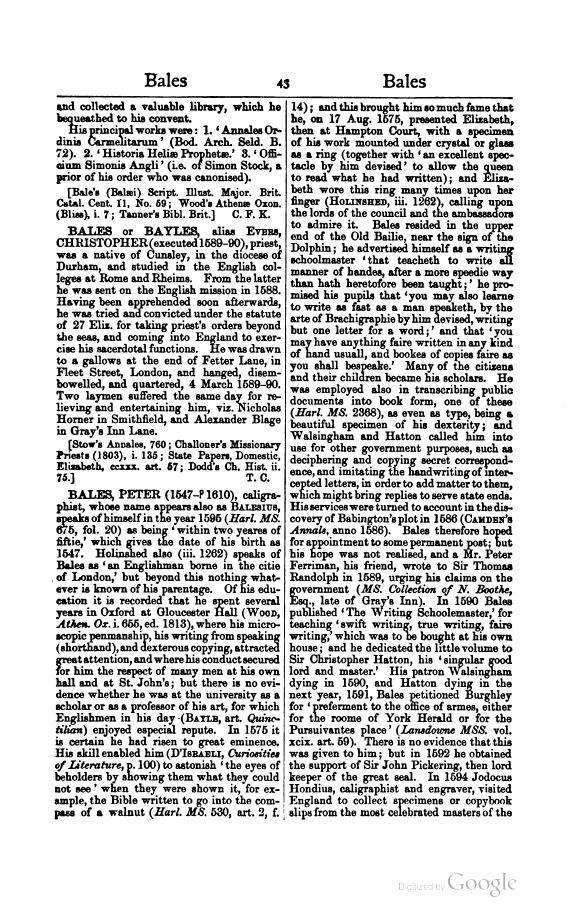and collected a valuable library, which he bequeathed to his convent.
His principal works were: 1. 'Annales Ordinis Carmelitarum' (Bod. Arch. Seld. B. 72). 2. 'Historia Heliæ Prophetæ.' 3. 'Officium Simonis Angli' (i.e. of Simon Stock, a prior of his order who was canonised).
[Bale's (Balæi) Script. Illust. Major. Brit. Catal. Cent. 11, No. 59; Wood's Athenæ Oxon. (Bliss), i. 7; Tanner's Bibl. Brit.]
BALES or BAYLES, alias Evers, CHRISTOPHER (executed 1589–90), priest, was a native of Cunsley, in the diocese of Durham, and studied in the English colleges at Rome and Rheims. From the latter he was sent on the English mission in 1588. Having been apprehended soon afterwards, he was tried and convicted under the statute of 27 Eliz. for taking priest's orders beyond the seas, and coming into England to exercise his sacerdotal functions. He was drawn to a gallows at the end of Fetter Lane, in Fleet Street, London, and hanged, disembowelled, and quartered, 4 March 1589-90. Two laymen suffered the same day for relieving and entertaining him, viz. Nicholas Horner in Smithfield, and Alexander Blage in Gray's Inn Lane.
[Stow's Annales, 760; Challoner's Missionary Priests (1803), i. 135; State Papers, Domestic, Elizabeth, ccxxx. art. 57; Dodd's Ch. Hist. ii. 75.]
BALES, PETER (1547–?1610), caligraphist, whose name appears also as Balesius, speaks of himself in the year 1595 (Harl. MS. 675, fol. 20) as being 'within two yeares of fiftie,' which gives the date of his birth as 1547. Holinshed also (iii. 1262) speaks of Bales as 'an Englishman borne in the citie of London,' but beyond this nothing whatever is known of his parentage. Of his education it is recorded that he spent several years in Oxford at Gloucester Hall (Wood, Athen. Ox. i. 655, ed. 1813), where his microscopic penmanship, his writing from speaking (shorthand), and dexterous copying, attracted great attention, and where his conduct secured for him the respect of many men at his own hall and at St. John's ; but there is no evidence whether he was at the university as a scholar or as a professor of his art, for which Englishmen in his day (Bayle, art. Quinctilian) enjoyed especial repute. In 1575 it is certain he had risen to great eminence. His skill enabled him (D'Israeli, Curiosities of Literature, p. 100) to astonish 'the eyes of beholders by showing them what they could not see' when they were shown it, for example, the Bible written to go into the compass of a walnut (Harl. MS. 590, art. 2, f. 14); and this brought him so much fame that he, on 17 Aug. 1575, presented Elizabeth, then at Hampton Court, with a specimen of his work mounted under crystal or glass as a ring (together with 'an excellent spectacle by him devised' to allow the queen to read what he had written); and Elizabeth wore this ring many times upon her finger (Holinshed, iii. 1262), calling upon the lords of the council and the ambassadors to admire it. Bales resided in the upper end of the Old Bailie, near the sign of the Dolphin; he advertised himself as a writing schoolmaster 'that teacheth to write all manner of handes, after a more speedie way than hath heretofore been taught;' he promised his pupils that 'you may also learne to write as fast as a man speaketh, by the arte of Brachigraphie by him devised, writing but one letter for a word;' and that 'you may have anything faire written in any kind of hand usuall, and bookes of copies faire as you shall bespeake.' Many of the citizens and their children became his scholars. He was emploved also in transcribing public documents into book form, one of these (Harl. MS. 2368), as even as type, being a beautiful specimen of his dexterity; and Walsingham and Hatton called him into use for other government purposes, such as deciphering and copying secret correspondence, and imitating the handwriting of intercepted letters, in order to add matter to them, which might bring replies to serve state ends. His services were turned to account in the discovery of Babington's plot in 1586 (Camden's Annals, anno 1586). Bales therefore hoped for appointment to some permanent post; but his hope was not realised, and a Mr. Peter Ferriman, his friend, wrote to Sir Thomas Randolph in 1589, urging his claims on the government (MS. Collection of N. Boothe, Esq., late of Gray's Inn). In 1590 Bales published 'The Writing Schoolemaster,' for teaching 'swift writing, true writing, faire writing,' which was to be bought at his own house; and he dedicated the little volume to Sir Christopher Hatton, his 'singular good lord and master.' His patron Walsingham dying in 1590, and Hatton dying in the next year, 1591, Bales petitioned Burghley for 'preferment to the office of armes, either for the roome of York Herald or for the Pursuivantes place' (Lansdowne MSS. vol. xcix. art. 59). There is no evidence that this was given to him ; but in 1592 he obtained the support of Sir John Pickering, then lord keeper of the great seal. In 1594 Jodocus Hondius, caligraphist and engraver, visited England to collect specimens or copybook slips from the most celebrated masters of the
